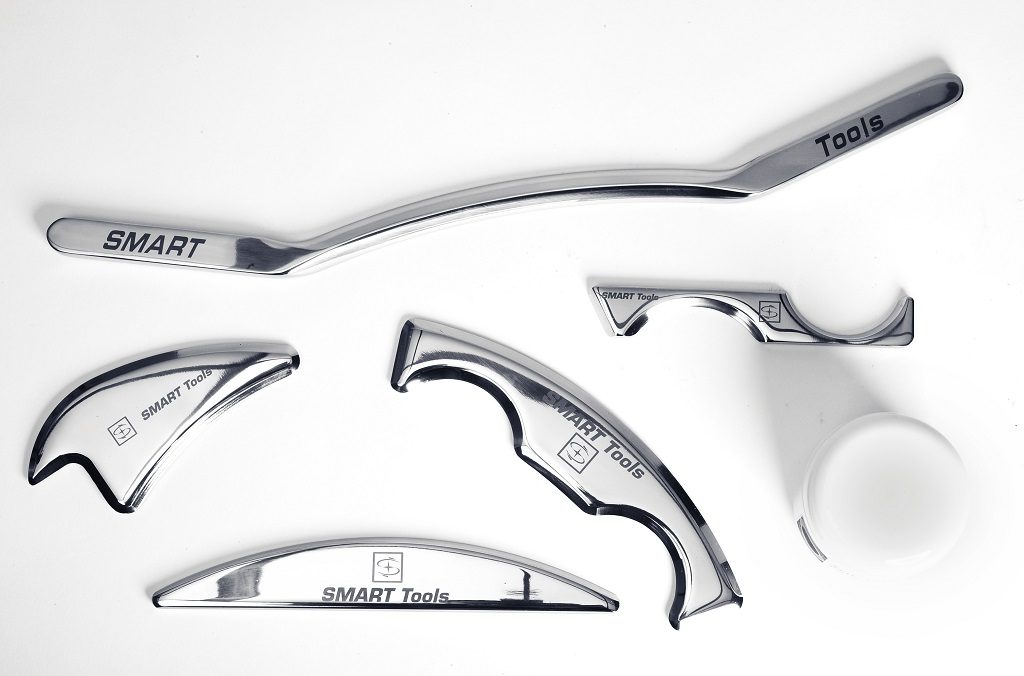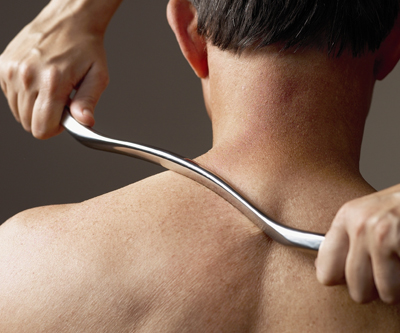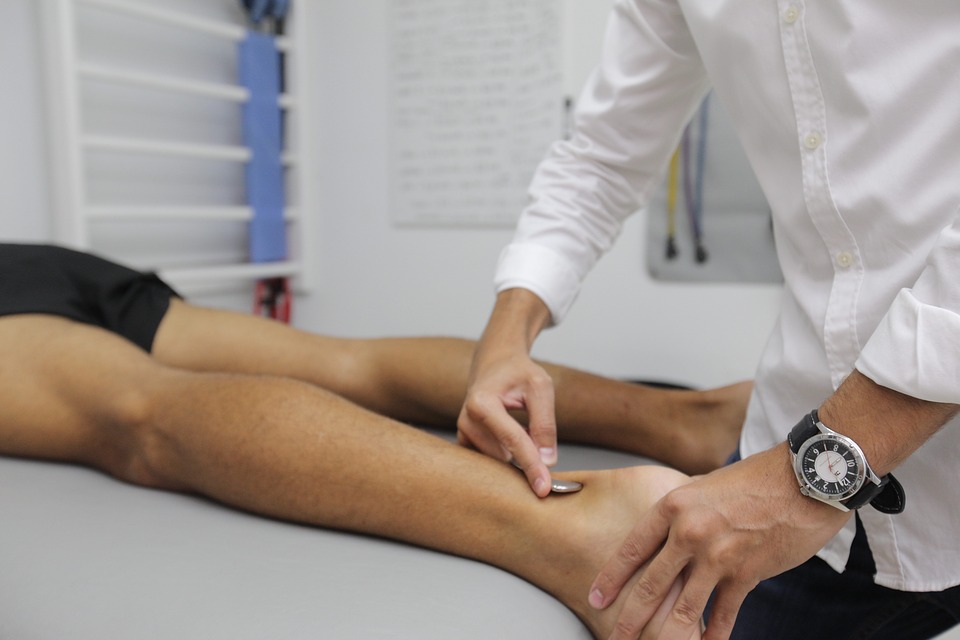IASTM, also known as “Instrument Assisted Soft Tissue Mobilization” or “Instrument Aided Soft Tissue Manipulation”, is a manual therapy approach to musculoskeletal injuries that utilizes specifically designed tools to relieve the target area. IASTM involves using a range of tools to enable clinicians to efficiently locate and treat individuals diagnosed with soft-tissue dysfunction.
You may have also heard this therapy called ASTYM or Graston. Both ASTYM and Graston are specific types of IASTM, much like a running shoe is a type of shoe or a sports car is a type of car.
Before we take a further look into IASTM, it’s important to understand what type of injuries these tools should be used with, and what those injuries are. The most common injuries that instrument assisted soft tissue mobilization tools are used to aid are soft tissue injures.
What Is a Soft Tissue Injury?
Soft tissue injuries are some of the most common injuries experienced by athletes and active individuals. A soft tissue injury involves damage to the muscles, ligaments, tendons and/or fascia somewhere in the body. Common soft-tissue injuries usually occur from a strain, sprain, blow to the body resulting in a contusion (ruptured blood vessels/bruising), or overuse of a particular muscle, muscle group or body part. Soft-tissue injuries can result in bruising, swelling, pain, and loss of function. Adhesions (scar tissue) within the soft tissue may develop as a result of surgery, immobilization, repeated strain, or other mechanisms. Use of a vibrating foam roller or massage ball, may be a first level approach for myofascial release, but if those are ineffective, IASTM could be a solution.
What injuries are typically treated with IASTM?
Originally designed to treat tendinitis, tendonosis, and tendonopathy, IASTM also provides relief and increased functional outcomes in other instances. Instrument Assisted Soft Tissue Mobilization is also often used on strains and sprains, arthritic joints, chronically painful tissues, post operative areas with proper scar and incision healing, and myofascial dysfunction just to name a few.
Common injuries or conditions that are often treated using an IASTM technique include: achilles tendinosis, rotator cuff injures, tendinitis, IT band syndrome, plantar fasciitis, and others. Below is a much more extensive list of injuries or conditions that have been known to incorporate Instrument Assisted Soft Tissue Mobilization into the recovery process.
- Medial Epicondylitis, Lateral Epicondylitis
- Carpal Tunnel Syndrome
- Neck Pain
- Plantar Fascitis
- Rotator Cuff Tendinitis
- Patellar Tendinitis
- Tibialis Posterior Tendinitis
- Heel Pain /Achilles Tendinitis
- DeQuervain’s Syndrome
- Post-Surgical and Traumatic Scars
- Myofascial Pain and Restrictions
- Musculoskeletal Imbalances
- Chronic Joint Swelling Associated with Sprains/Strains
- Ligament Sprains
- Muscle Strains
- Non-Acute Bursitis
- RSD (Reflex Sympathetic Dystrophy)
- Back Pain
- Trigger Finger
- Hip Pain (Replacements)
- IT Band Syndrome
- Shin Splints
- Chronic Ankle Sprains
- Acute Ankle Sprains (Advanced Technique)
- Scars (Surgical, Traumatic)
- Pain During Motion
- Limited Motion or Fascial Tension
- Fascial Densification
- Trigger Points
- Motor Control Issues
When to avoid IASTM
IASTM isn’t always an appropriate method of relief and you should consult with a doctor or therapist prior to doing so. If you have any of the following conditions, it is highly recommended that you avoid IASTM:
- Open wounds
- Infections
- Tumors
- Active implants
- pacemaker, internal defibrillator, picc/pump lines
- Deep Vein Thrombosis (DVT)
- Cervical carotid sinus
How does IASTM work?
Often times, individuals with soft-tissue injuries do not seek out professional medical help until their injuries have become chronic. This can often be weeks or months after the initial injury. By this time, the body has already completed most of its self-healing process. In the healing process, scar tissue and adhesions are formed, which can limit motion and often cause pain. These scar tissues and adhesions essentially act like super glue within your soft tissue. When scar tissue is created after injury, new cells are laid down excessively and in a disorganized manner. Under a microscope, scar tissue appears as a plate of cooked spaghetti, whereas normal tissue appears as a box of uncooked spaghetti. While scar tissue is an effective healer, it is not the most flexible. Due to the tissue disorganization, scar tissue and adhesions prevent the muscle or other tissues from lengthening appropriately. IASTM works to correct this and allow a more organized pattern of tissues to develop.
While there are many purposes behind IASTM, the various techniques are designed to produce a healing response from the body. This is done in order to remodel the soft tissues in the affected area. By introducing controlled micro-trauma to affected soft tissue using IASTM, a local inflammatory response is stimulated. This micro-trauma initiates re-absorption of inappropriate or excessive scar tissue and promotes a remodeling of the affected soft-tissue structures. After Instrument Assisted Soft Tissue Mobilization treatment, scar tissue can be remodeled so that the cells become organized in a direction that better promotes movement (like uncooked spaghetti).
The greatest effects and most positive outcomes from IASTM are experienced when the individual conducting the therapy is aware of the fascial connections above, below, and surrounding the affected area. The therapist should be knowledgeable enough to treat an entire limb, as opposed to spot treating. For example, when treating an elbow problem, it is expected that the therapist will treat up into the shoulder and down into the wrist and hand.
It’s also important to note that in order to achieve maximum results with IASTM, a comprehensive exercise program should complement the therapy. An exercise program is necessary to strengthen the affected tissues, remodel the underlying tissues and create new movement patterns.
What is involved in a typical IASTM treatment session?
First, a therapist will typically warm up the tissue to help make it more pliable. Depending on the injured area, the warm up routine could involve heat or exercise.
Once the tissue is warmed up, the therapist will perform the Instrument Assisted Soft Tissue Mobilization.
To ensure a full benefit from the IASTM session, the therapist will have the patient engage in light exercise to help promote proper movement patterns and strengthen the tissues. Performing these exercises after an IASTM session will greatly accelerate the healing process and help ensure that the new tissues are formed properly.
What are the benefits of IASTM?
The benefits of Instrument Assisted Soft Tissue Mobilization are not exclusive to the patient, as there are also benefits to the therapist or medical professional. Below we highlight some of the potential benefits of the manual therapy for both patients and therapists.
- Break up abnormal densities, such as scar tissue
- Stimulate nervous system
- Increased vascular response
- Re-initiate first-stage healing in the body via proliferation
- Remodeling of unorganized collagen fiber matrix
- Improved flexibility and range of motion of injured area
- Improved responsiveness of injured area
- Increased strength following treatment
- Increased pain perception in the area
- Provides clinicians with a mechanical advantage, thus preventing over-use to their hands
Side effects of the treatment may include mild bruising along the lines of treatment, and delayed onset muscle soreness. Often times, patients describe a general warming feeling, or even some tingling in the treated areas for up to 24 hours.
How are IASTM tools used?
IASTM tools were developed to assist in the treatment of adhesions and scarring brought on by surgeries, injuries, and overuse of muscles. These tools help to assist medical doctors, osteopathic doctors, chiropractors, physical therapists, physical therapy assistants, occupational therapists, athletic trainers, massage therapists, acupuncturists, and others to effectively treat patients with less fatigue to the practitioner. This will enable the practitioner to create a controlled inflammatory process, which will allow the tissue to begin the healing process, breaking down scar tissue/adhesions in the troubled area, and accelerate the recovery process.
IASTM is used extensively in the outpatient orthopedic setting due to the results generated with the technique. The tools do not replace the hands of a Physical Therapist or medical professional, but only add another option in a therapist’s manual therapy tool bag and allow them to provide a more consistent treatment.
What should I expect after an IASTM treatment?
It is important to note that IASTM’s ability to reinitiate first-stage healing comes from the fact that it is essentially reinjuring the body (although to a lesser degree and in a controlled fashion). This may cause mild discomfort during the procedure. Patients may experience soreness in the treatment area for a day or two following treatment. Bruising can occur, although this is neither common nor desirable.
How many IASTM treatments should I expect before I improve?
Results vary from individual to individual. It is common for patients to receive two treatments per week, over 4-5 weeks. Most patients have a positive response by the 3rd or 4th treatment.
As mentioned above, it is important to incorporate a strength and exercise program into your treatment schedule to ensure the highest likelihood of success.
What are IASTM tools made of?
Many different materials have been used to make the instruments (i.e. wood, ceramics, plastics, stone and stainless steel) used by professionals that practice this manual therapy. One of the most popular materials for IASTM tools is stainless steel, however the type of material can vary dependent upon the type of IASTM being performed (i.e. Graston or ASTYM). Below are some of the most common materials utilized within the various forms of this manual therapy.
- Buffalo Horn -These tools are commonly used for the practice of Gua Sha, but can also be used for IASTM too. While they can be used, they are not very popular because the tissue is not always the most responsive. However, if you are looking for a cheaper option, this could be something to consider.
- Jade Tools – Much heavier and more slippery than the buffalo horn. If jade tools are utilized, the user should be careful as these can break easily if dropped.
- Plastic Tools – These tools are largely used for training purposes before upgrading to stainless steel tools. While plastic tools are relatively new to the market, there are lots of designs available.
- Stainless Steel Tools – These are the best and most popular tools for IASTM. Almost any medical professional will have stainless steel tools because the tissue responds the best to this material. The steel tools come in varying sizes and shapes for targeting different parts of the body.

Types of IASTM tools
There are different varieties of tools and companies with different treatment approaches and instrument design (material, shape etc) to perform IASTM. Some popular manufacturers of these tools are Edge Mobility System, Smart Tools, Endiglo, Hawk Grips, Zuka Tools, and Myofascial Tools.


